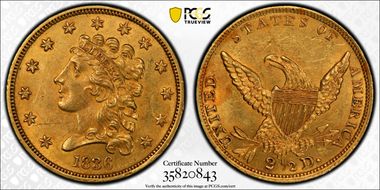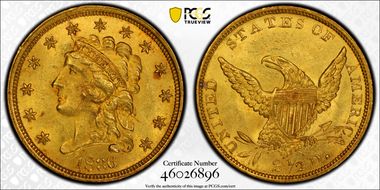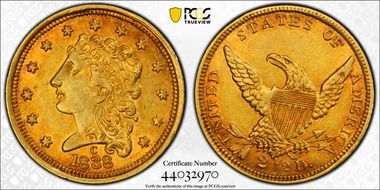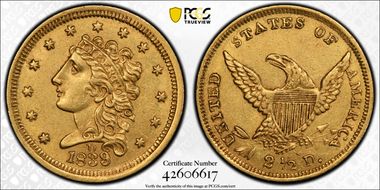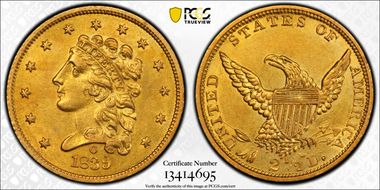Classic Head Quarter Eagles by die pairing 的展示图片库
CAC/OGH, HM-2, R-3. Obverse 2: Large indent in hair at bottom of the portrait. Reverse B: Widely spaced A M in AMERICA; split berry. This example has vivid golden-olive surfaces which are further enlivened by intense luster in a satin to semi-reflective finish. It is well struck with bold details throughout. PCGS Gen 3.0 Holder. Stack’s Bowers 3/23: 7015.
CAC, HM-2, R-3. Obverse 2: Large indent in hair at bottom of the portrait. Reverse B: Widely spaced A M in AMERICA split berry. This example is pleasing olive with orange toning, particularly prevalent on the reverse. IBE in the Liberty Band and the hair below it are weakly struck. Otherwise, the strike is good. Heritage 2/22: 7209.
HM-3, R-4+. Obverse 2 is the same die as HM-2. Reverse C: Small Split Berry, closely spaced AM and elongated dentil below the ½ on the reverse; this obverse die is unique. This is the scarcest die pairing in 1834. The strike is weak, particularly on Liberty’s hair and the corresponding central devices on the reverse. This coin has great luster, yellow-gold coloration and wear consistent with the grade. Stack’s Bowers 4/21: 11474.
HM-4, early die state, R4. Obverse 2 is the same die as HM-2 and HM-3. Reverse D: M in AMERICA is missing the right diagonal. This is the second rarest pairing in 1834 representing only 12% of the anticipated survivors. This vibrant prooflike yellow-gold example has a very strong strike. Unlike many examples from later die states, this coin does not have the die bulges and die deterioration frequently seen on this reverse. Purchased from Paul Nugget.
HM-1, R-5+, Haynor. The Mint used only a single obverse die to strike all 1835 quarter eagles. On the reverse the M in AMERICA is missing the right diagonal. Prooflike medium gold surfaces exhibit warm honey-olive undertones. Like most (all?) 1835 Quarter Eagles, the strike is noticeably soft in the central devices. Stack’s Bowers 8/2022: 5005 (Daryl Haynor’s The Virginian Collection).
CAC, HM-2, R-3. Obverse 1: The Mint used a single obverse die to strike all 1835 quarter eagles. Reverse B: Widely spaced A M in AMERICA split berry; the same as 1834 HM-2. This is the most common pairing in 1835 representing over 85% of the assumed survivors. As with all 1835 Quarter Eagles, the central devices are weakly struck but this example has better definition than most. The color is green-gold and the surfaces are prooklike. A beautiful example of this date. Purchased from Crescent City Numismatics.
HM-3, R-5. Obverse 1: The Mint used only one obverse die to strike all 1835 quarter eagles. Reverse E: No Berry; AMERICA is evenly spaced. This example has a fine frosty luster. The underlying color is green-gold with red-orange toning throughout. This die pairing is weakly struck; the central devices on both sides lack most detail. The stars on this example have full radial lines. The obverse has a die crack that runs from the left of star six to the bottom of Liberty’s curls. The date and stars 1, 12 and 13 have distinct doubling. The reverse has a die crack from the bottom of A through E in STATES. A very interesting and attractive coin. Purchased from Crescent City Numismatics.
CAC, HM-1, Block 8, R-3. Obverse 1: Curved profile and large indent in hair at bottom of portrait; this obverse die is unique. Reverse F: VERY weak detached tongue; 3rd Arrowhead under right base of A. This example is green-gold with orange-gold toning and pleasing cartwheel luster. The strike is very strong except for some minor weakness on the hair below the Liberty Band. Purchased from DLRC.
HM-3, Script 8, R-7, Haynor. Obverse 3: Stars close to dentils; 18 in date are close. This obverse is unique. Reverse E is the same as 1835 HM-3 and is the only reverse in 1836 with no berry. This is the rarest circulation strike die marriage in the Classic Head Series (10 anticipated survivors). Both sides have attractive warm honey-orange color with remnants of frosty luster in the recessed areas. The obverse is soft at the center as is the reverse at the shield and within the feathers of the eagle's right shoulder and leg. As with many softly struck Classic Head quarter eagles of all dates and die pairings, the detail on this coin sharpens considerably toward the borders. An obverse bisecting die crack runs from the rim to the right side of star 6 to the border between stars 11 and 12. The reverse has die cracks from the left wing tip to many cracks in STATES. Stack’s Bowers 8/2022: 5009 (Daryl Haynor’s The Virginian Collection).
CAC, HM-4, Script 8, “early/intermediate” die state, R-1. Obverse 4: Curved Profile; Star 6 points to lowest portion of first hair curl. Reverse E is the same as HM-3 and 1835 HM-3 and is the only reverse in 1836 with no berry. This example is a light orange-gold with darker rust tones clinging to some peripheral devices. The luster is frosty, and the strike is somewhat soft in the centers. On the obverse, there is a typical die crack from the rim left of star six to the area between stars 12 and 13, almost to the rim. This crack is very heavy near star 6 and faint between the final stars. On the reverse, the die cracks are less prevalent than “normal”; there is no crack from the left wing tip to the first S or from S to T in STATES. There are however cracks at the top of both sides of the T and connecting the bases of ATES. Purchased from Crescent City Numismatics.
CAC, HM-4, Script 8, “late/intermediate” die state, R-1. Obverse 4: Script 8; Curved Profile; Star 6 points to lowest portion of first hair curl. Reverse E is the same as HM-3 and 1835 HM-3 and is the only reverse in 1836 with no berry. Well struck despite the deteriorating condition of the obverse die. The luster is muted, and the color is orange-gold with scattered hints of cherry-red. The obverse has a bisecting die crack which runs from the left of star 6 through Liberty and the field between stars 12 and 13. This crack is met above the ear with a crack to the lower jaw. The reverse does not have the “normal” crack from the left wing to through the lower base of S but does have a shallow crack from the top left of the shield to the Eagle’s beak. Heritage 12/22: 3581.
HM-5, Script 8, R-5. Obverse 4 is the same as HM-4 and HM-6. Reverse B is the same as 1834 HM-2, 1835 HM-2 and 1836 HM-2. This orange-gold example has extensive red-orange toning on both surfaces. The frosty luster is prevalent on “bright” surfaces. The strike is bold but the reverse demonstrates lapped dies with the loss of detail in areas like the branch stem. This is the first use of Obverse 4 and does not show the die cracks seen on most 1836 Script 8 examples. Purchased from Eye Appealing Coins.
CAC, HM-6, Script 8, R-4. Obverse 4 is the same as HM-5 and HM-6. Reverse G: The second arrowhead runs past the C, almost to the I; the reverse die is unique. This honey-gold example has a good strike except for the central areas of both surfaces. It has excellent luster for the grade and “crusty dirt” clinging to several devices. The obverse has a rim to rim die crack from 11 o’clock to 5 o’clock and another from the cheek curl to the back of the jaw. The reverse has a die chip in the lower left quadrant of the D in UNITED. Purchased from Daniel Boone Coins.
HM-7, Block 8, R-6, Haynor. The obverse of this die marriage is identified by a block 8. The reverse is the same as HM-3; it has no berry. The paucity of 1836 HM-7 quarter eagles is due to a small press run caused by the early break up of Obverse 5. Evidence for this is clearly seen on this coin, which shows three prominent cracks: a branching one at the back of Liberty's head to the border between stars 11 and 12; from the lower border through the digit 6 in the date and into the portrait; and from the border between stars 3 and 4 through Liberty's nose, cheek and ear. Vivid golden-yellow surfaces reveal subtle olive highlights under a light. The texture is frosty with good luster quality and a very smooth appearance for the assigned grade. The strike is soft in the center on both sides. Stack’s Bowers 8/2022: 5013 (Daryl Haynor’s The Virginian Collection).
CAC, HM-8, Block 8. Obverse 6: Profile very straight; Star 6 points to LOWER edge of the hair band, wide back of mouth; this obverse die is unique. Reverse F is the same as HM-1. This is a crusty old soldier with a great deal of dirt clinging to devices on both surfaces. The color is green gold with orange highlights. Like most examples of this die pair, the strike is very weak on and surrounding LIB on the obverse and the eagles’ left leg on the reverse. Previously in an NGC AU50 holder. Purchased from Crescent City Numismatics.
HM-1, R-3, Bass-Haynor. Obverse 1: Star 8 points to the left side of the third curl on the top of Liberty's head; Bulbous lower lip and open mouth. Reverse A is the same as 1834 HM-1. This is the finest known 1837 Quarter Eagle. Boldly to sharply rendered throughout, this coin exhibits superior definition for a circulation strike quarter eagle of the type. Beautiful satin surfaces exhibit a few blushes of faint powder blue iridescence on dominant golden-orange color. There is a faint die crack from the top of the 8 into Miss Liberty’s hair. New York Gold Mart; ex: Stack’s Bowers 8/2022: 5015 (Daryl Haynor’s The Virginian Collection); ex: Harry W. Bass, Jr. Collection, Part II, October 1999, lot 305.
HM-2, R-7, Haynor. This variety is the rarest 1837 circulation strike. There are only 12-14 expected survivors. The obverse uses the same die as the 1837 HM-1. On the reverse, the third arrowhead does not touch the last A in AMERICA. Generally smooth surfaces retain ample reflectivity around the peripheries and within the protected areas of the design elements. The central devices on both surfaces are soft and the color is a “medium” gold. Stack’s Bowers 8/2022: 5016 (Daryl Haynor’s The Virginian Collection); ex: Stack’s Bowers August 2014 ANA Auction, lot 11047 (Dr. James A. Ferrendelli Collection), as NGC AU-50, unsold.
CAC, HM-1, R-3. Obverse 1 (unique) and Reverse H which is the same as 1837 HM-3; there is only one die pairing in 1838. Beautiful frosty luster adorns green gold surfaces. The strike is extremely strong and there are no significant contact marks. The obverse has a wide rim and small denticles. It would be a pleasure if all coins were graded this conservatively. Purchased from Crescent City Numismatics.
CAC, HM-1, R-4. There is a single die pair known. The obverse is unique; the reverse was subsequently used for 1839-C HM-1; there is only one die pairing in 1838-C. Virtually Mint State, this impressive piece has a trace of rub on the high points with minuscule handling marks. Both sides display lustrous green-gold surfaces with gorgeous peripheral rose toning. Although not clearly visible on the PCGS image, there is a distinct die crack from the left shield through the eagle’s lower beak. This crack may have led to the soft strike at the juncture of the shield and the eagle’s left wing. Heritage 9/23: 3101,
HM-1, R-4. Obverse 1 (unique) and Reverse F which is the same as 1836 HM-1 and HM-8 and 1837 HM-2; there is only one die pairing in 1839. This is a rare mint state example. The green-gold color is accented by light orange toning toward the periphery on the obverse. The strike is strong with any weakness consistent with other high-grade examples. There are minor reeding marks on the obverse portrait. Purchased from Crescent City Numismatics.
CAC, HM-1, R-4. Obverse 1 (unique) and Reverse F which is the same as 1836 HM-1 and HM-8 and 1837 HM-2; there is only one die pairing in 1839. This is an exceptional example with “dirt” clinging to several devices and green gold color dramatically accented by red orange toning. The strike is strong with any weakness consistent with other high grade examples. Heritage 1/22: 3894 (as an NGC AU58).
HM-3, R-4+. Obverse 2: The C is over the left side of the 3. Reverse K: The rounded branch tip extends to the left serif of the D and the 1 in ½ is far from the bar; this reverse die is unique. This is the second year of production of Classic Head Quarter Eagles at the Charlotte mint. The year featured three die pairings; the HM-3 is the second rarest of the three. On this example, the strike is strong for the issue, has a satin texture, and the color is orange-gold. On the obverse, there is a “strike through” on the face that is typical for obverse 2; this characteristic has been given the nickname “bandit face”. On the reverse, there is a large die crack through the E in STATES into the field above the eagle.
HM-1, R-5. Obverse 1 is the only obverse used for 1839-D coins. Reverse L: Berry; the branch stem is bold and entirely to the left of the D; the reverse die is unique. In 1839, the Dahlonega mint had a single year of production for Classic Head Quarter Eagles. It is the only year where the mint mark was on the obverse. This green-gold example has a strong strike and ample luster. There are three die cracks on the reverse; from the rim through the center of the second T in STATES almost to the eagle’s head, at the bottom of ED to the rim and from the third leaf to the rim. The latter two cracks are very thin, denoting the beginning of the die’s deterioration. Purchased from New York Gold Mart.
CAC, HM-2, R-4. In 1839, the Dahlonega mint had a single year of production for Classic Head Quarter Eagles. It is the only year where the mint mark was on the obverse. The year had one obverse and two reverses. The reverse is identified by no berry, and a weak branch stem approaching the upright of D in the denomination. This green-gold representative shows striking weakness on the middle letters in LIBERTY. Noticeable frosty luster remains. Purchased from Heritage; ex: SB 11/21: 4091.
CAC, HM-1, R-3. This die marriage represented the first gold coins struck at the New Orleans mint. This variety has the traditional layout with a coin turn unlike the HM-2 which has a “medal turn”; it has a high date on the obverse and a wide fraction on the reverse. The obverse indicates a late die state because die polishing has fragmented the curls by the Y in LIBERTY. The reverse has several die cracks near UNITED but does not have the die cracks near STATE OF that would indicate a really late die state. Sharply struck devices show a glowing frosty luster that blooms around the protected areas. Rich green-gold color enhances high-quality fields. Purchased from Crescent City Numismatics.
HM-1 (Late die state), R-3. Obverse 1: High Date with the 3 lower than other digits; this obverse die is unique. Reverse N: Wide fraction, no berry and a weak branch stem; the reverse die is unique. This die pairing represented the first gold coins struck at the New Orleans mint. This variety has the traditional layout with a coin turn unlike the HM-2 which has a “medal turn”. The surfaces are green gold with frosty luster. The devices are sharply struck but extensive die polishing shows fragmented curls by the Y in LIBERTY on the obverse and thinning of the leaves, arrow shafts and feathers on the reverse. The reverse has extensive die cracks – one runs from the bottom of T through the bottom of I in UNITED through leaf 1 to the 2 in 2 ½ to the rim. The second runs from the bottom of A to the top of M in AMERICA. Purchased from Stack’s Bowers.
HM-2, R-4, Haynor. This die marriage is identified by an obverse with a low date and tall upper serif on the 1 and a reverse with a “close fraction”. This variety has a “medal turn”, the only variety of Classic Head Quarter Eagles with this mint error. Honey-orange color on both sides, with rose highlights. Appreciable mint frost remains on surfaces that are impressively smooth for an early date New Orleans Mint gold coin. Both sides are crisply impressed with sharp to full detail in virtually all areas. Adding interest to this example, there are several prominent cracks: bisecting the eagle's head from the border outside its right wing tip to the border outside its left wing tip; from the lower left border through the left upright of the letter N in UNITED and the uppermost pair of leaves; from the lower right border through the letter R in AMERICA, then curving abruptly to join the uppermost arrow head, then continuing through the arrow shaft and talons to join the crack from the letter N in UNITED. Stack’s Bowers 8/2022: 5026 (Daryl Haynor’s The Virginian Collection).



























